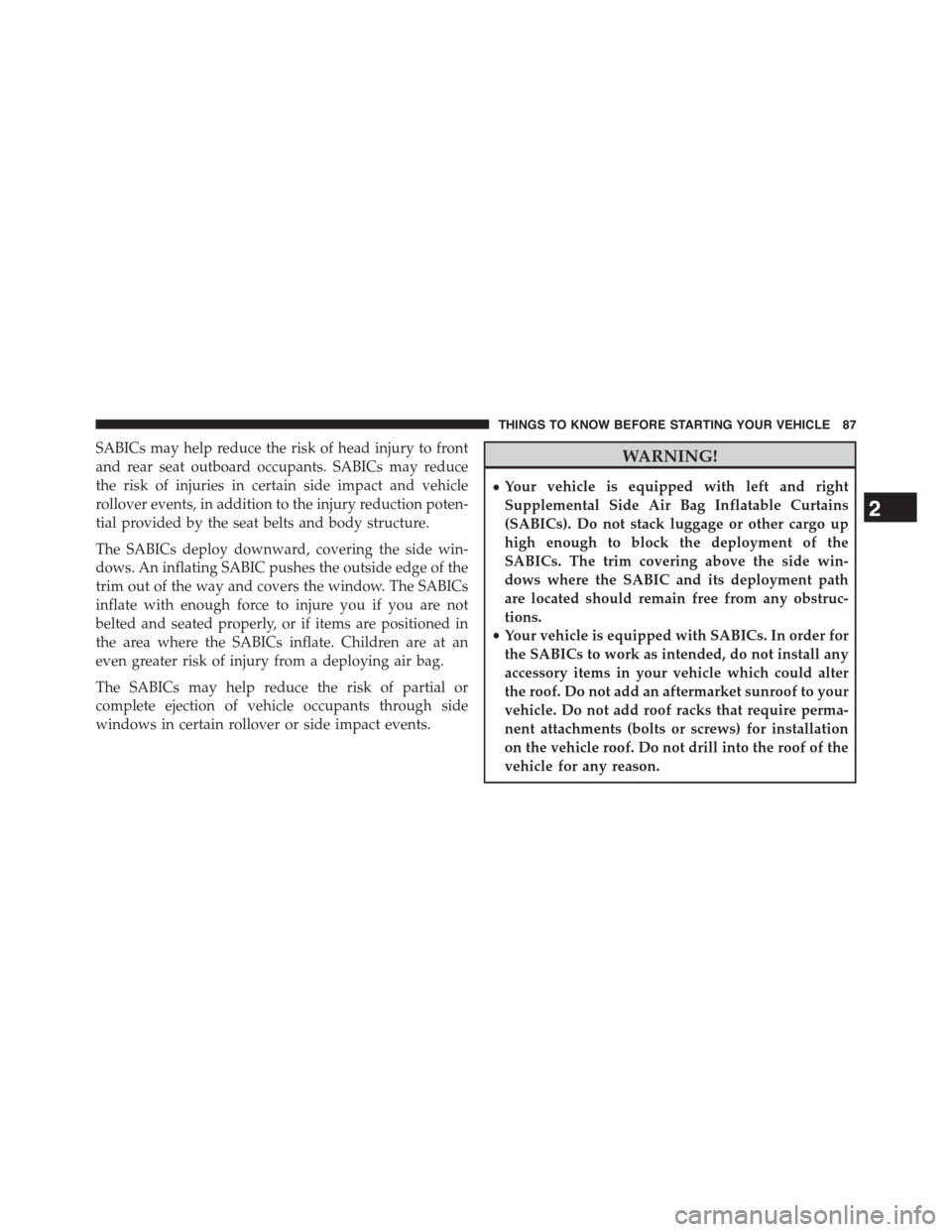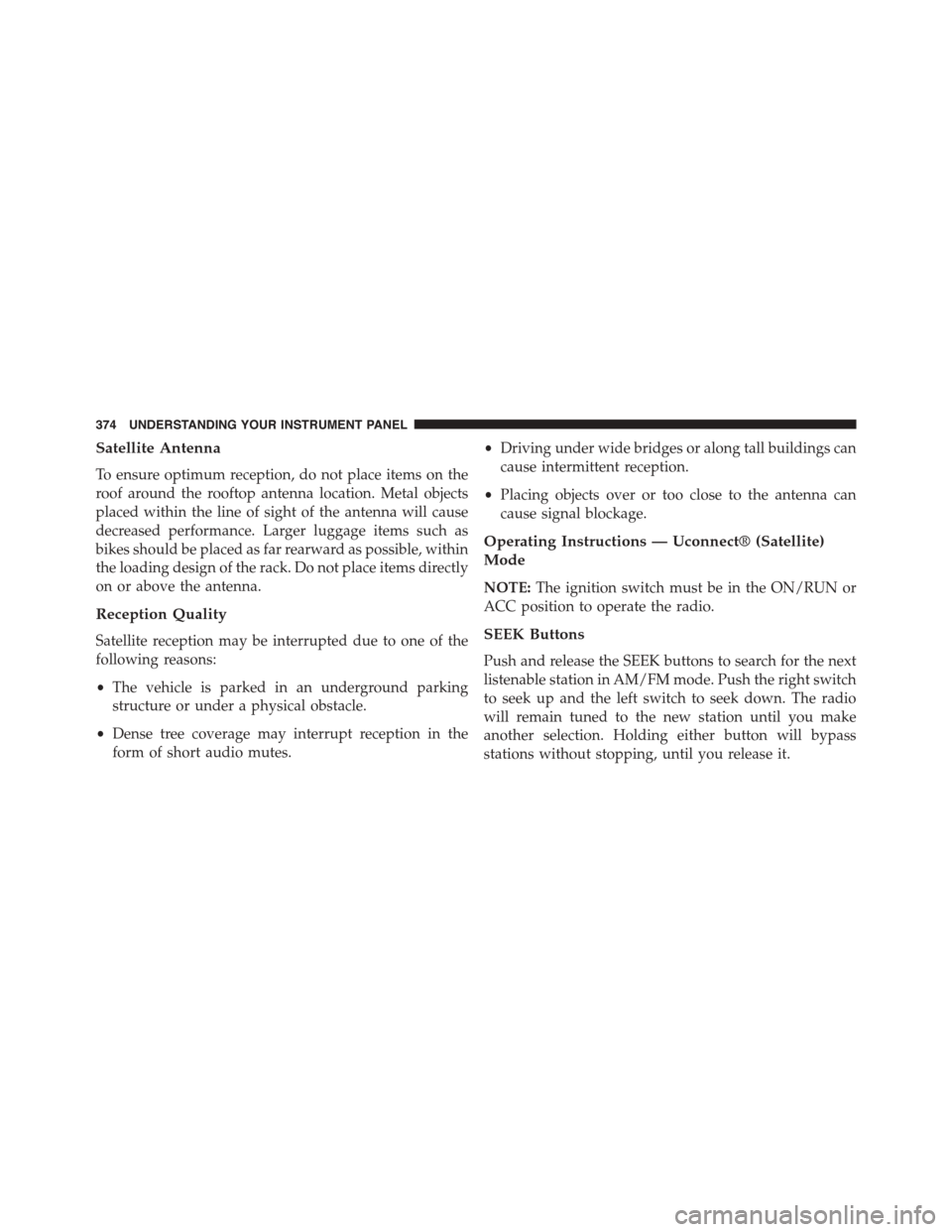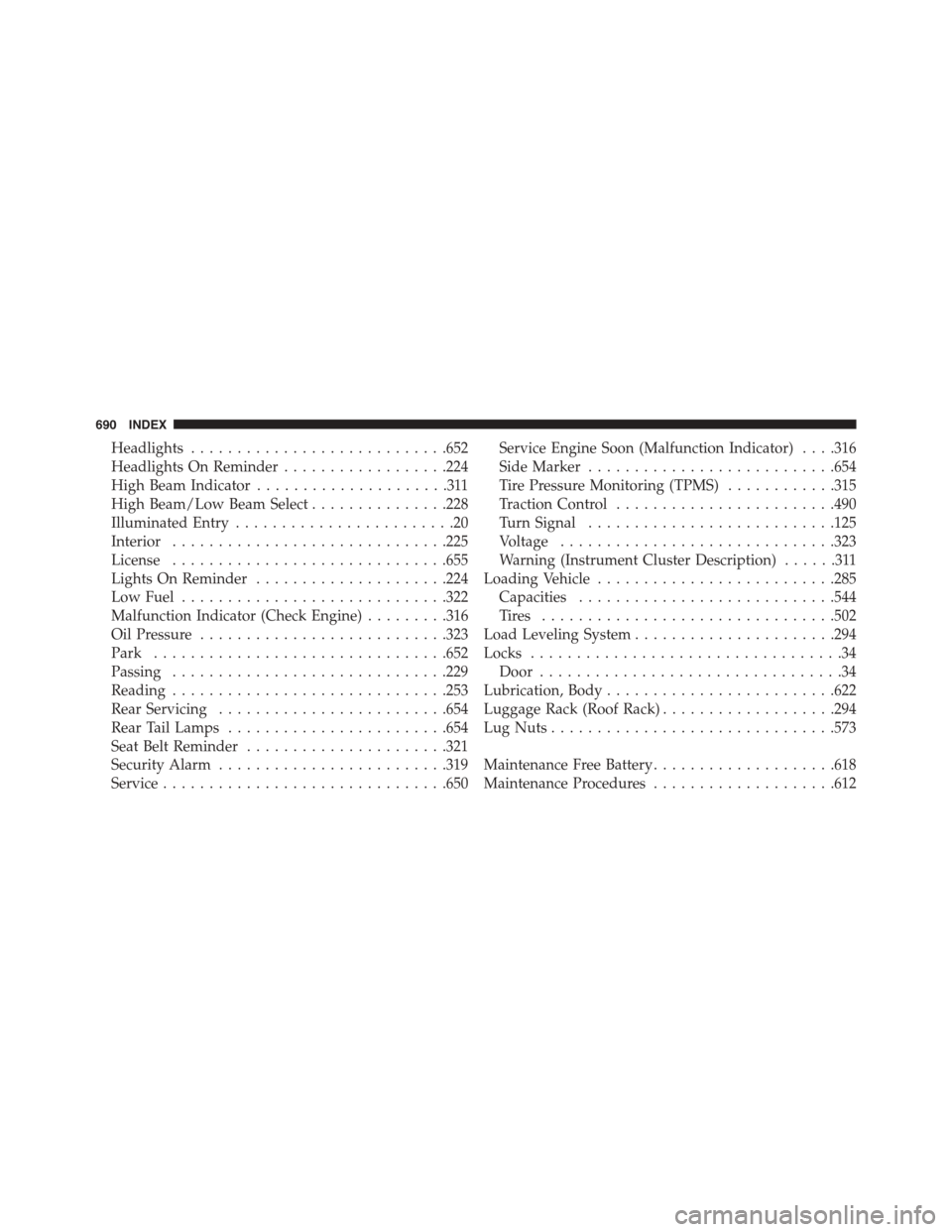Page 89 of 703

SABICs may help reduce the risk of head injury to front
and rear seat outboard occupants. SABICs may reduce
the risk of injuries in certain side impact and vehicle
rollover events, in addition to the injury reduction poten-
tial provided by the seat belts and body structure.
The SABICs deploy downward, covering the side win-
dows. An inflating SABIC pushes the outside edge of the
trim out of the way and covers the window. The SABICs
inflate with enough force to injure you if you are not
belted and seated properly, or if items are positioned in
the area where the SABICs inflate. Children are at an
even greater risk of injury from a deploying air bag.
The SABICs may help reduce the risk of partial or
complete ejection of vehicle occupants through side
windows in certain rollover or side impact events.
WARNING!
•Your vehicle is equipped with left and right
Supplemental Side Air Bag Inflatable Curtains
(SABICs). Do not stack luggage or other cargo up
high enough to block the deployment of the
SABICs. The trim covering above the side win-
dows where the SABIC and its deployment path
are located should remain free from any obstruc-
tions.
•Your vehicle is equipped with SABICs. In order for
the SABICs to work as intended, do not install any
accessory items in your vehicle which could alter
the roof. Do not add an aftermarket sunroof to your
vehicle. Do not add roof racks that require perma-
nent attachments (bolts or screws) for installation
on the vehicle roof. Do not drill into the roof of the
vehicle for any reason.
2
THINGS TO KNOW BEFORE STARTING YOUR VEHICLE 87
Page 134 of 703

▫Premium Console Cupholders — If Equipped. . .277
▫Interior Bottle Holders..................277
▫Smoker’s Package Kit — If Equipped.......278
!STORAGE............................279
▫Glove Compartments..................279
▫Door Trim Panel Storage................280
▫Driver Seatback Storage — If Equipped......280
▫Umbrella Holder.....................281
▫Second Row Seat Storage Bins — If Equipped . .282
▫Storage Bin Safety Warning...............283
▫Coat Hooks.........................285
▫Cargo Area Storage....................285
!CONSOLE FEATURES...................286
▫Basic Console........................286
▫Premium Console — If Equipped..........287
▫Super Console — If Equipped.............291
!REAR WINDOW FEATURES..............293
▫Rear Window Defroster.................293
!LOAD LEVELING SYSTEM — IF EQUIPPED . .294
!ROOF LUGGAGE RACK — IF EQUIPPED . . . .294
▫Deploying The Crossbars................295
!SUN SCREENS — IF EQUIPPED............300
132 UNDERSTANDING THE FEATURES OF YOUR VEHICLE
Page 296 of 703

LOAD LEVELING SYSTEM — IF EQUIPPED
The automatic load leveling system will provide a level-
riding vehicle under most passenger and cargo loading
conditions.
A hydraulic pump contained within the shock absorbers
raises the rear of the vehicle to the correct height. It takes
approximately 1 mile (1.6 km) of driving for the leveling
to complete depending on road surface conditions.
If the leveled vehicle is not moved for approximately 15
hours, the leveling system will bleed itself down. The
vehicle must be driven to reset the system.
ROOF LUGGAGE RACK — IF EQUIPPED
The crossbars on your vehicle are delivered stowed
within the roof rack side rails. If adding cargo, deploy the
crossbars. Distribute cargo weight evenly on the roof rack
crossbars, to maximum of 150 lbs (68 kg). The roof rack
does not increase the total load carrying capacity of the
vehicle. Be sure the total load of cargo inside the vehicle
plus that on the external rack does not exceed the
maximum vehicle load capacity.
The crossbars and side rails are designed to carry weight
on vehicles equipped with a luggage rack. The load must
Crossbar Stowed In Side Rail
294 UNDERSTANDING THE FEATURES OF YOUR VEHICLE
Page 297 of 703
not exceed 150 lbs (68 kg), and should be uniformly
distributed over the luggage rack crossbars.
NOTE:
•Crossbars are error-proofed and cannot be deployed or
stowed in the incorrect positions.
•To help control wind noise, stow the crossbars in the
side rails when they are not in use.
Deploying The Crossbars
To deploy the crossbars, completely loosen the thumb
screws at both ends of the crossbar and lift the crossbar
from its stowed position in the side rail. Repeat with
crossbar on the opposite side.CAUTION!
Use care when removing and handling the crossbars
to prevent damage to the vehicle.
Loosening Crossbars
3
UNDERSTANDING THE FEATURES OF YOUR VEHICLE 295
Page 301 of 703

CAUTION!
•Check deployed crossbars frequently and retighten
thumb screws as necessary.
•To avoid damage to the roof rack and vehicle, do
not exceed the maximum roof rack load capacity of
150 lb (68 kg). Always distribute heavy loads as
evenly as possible and secure the load appropri-
ately.
•To prevent damage to the roof of your vehicle, DO
NOT carry any loads on the roof rack without the
crossbars deployed.
•The load should be secured and placed on top of
the crossbars, not directly on the roof. If it is
necessary to place the load on the roof, place a
blanket or other protective layer between the load
and the roof surface.
(Continued)
CAUTION!(Continued)
•Long loads which extend over the windshield, such
as wood panels or surfboards, or loads with large
frontal area should be secured to both the front and
rear of the vehicle.
•Travel at reduced speeds and turn corners carefully
when carrying large or heavy loads on the roof
rack. Wind forces, due to natural causes or nearby
truck traffic, can add sudden upward lift to a load.
This is especially true on large flat loads and may
result in damage to the cargo or your vehicle.
3
UNDERSTANDING THE FEATURES OF YOUR VEHICLE 299
Page 302 of 703
WARNING!
Cargo must be securely tied before driving your
vehicle. Improperly secured loads can fly off the
vehicle, particularly at high speeds, resulting in per-
sonal injury or property damage. Follow the roof rack
cautions when carrying cargo on your roof rack.
SUN SCREENS — IF EQUIPPED
Sun screens are available for second and third row
seating windows. The screens store in the sill trim panels,
and the tops of the windows are equipped with hooks
that the sun screens attach to when pulled out.Gently pull up on the tab to raise the sun screen. Continue
pulling the sun screen until the tab is near the top of the
window.
Sun Screen Retracted
300 UNDERSTANDING THE FEATURES OF YOUR VEHICLE
Page 376 of 703

Satellite Antenna
To ensure optimum reception, do not place items on the
roof around the rooftop antenna location. Metal objects
placed within the line of sight of the antenna will cause
decreased performance. Larger luggage items such as
bikes should be placed as far rearward as possible, within
the loading design of the rack. Do not place items directly
on or above the antenna.
Reception Quality
Satellite reception may be interrupted due to one of the
following reasons:
•The vehicle is parked in an underground parking
structure or under a physical obstacle.
•Dense tree coverage may interrupt reception in the
form of short audio mutes.
•Driving under wide bridges or along tall buildings can
cause intermittent reception.
•Placing objects over or too close to the antenna can
cause signal blockage.
Operating Instructions — Uconnect® (Satellite)
Mode
NOTE:The ignition switch must be in the ON/RUN or
ACC position to operate the radio.
SEEK Buttons
Push and release the SEEK buttons to search for the next
listenable station in AM/FM mode. Push the right switch
to seek up and the left switch to seek down. The radio
will remain tuned to the new station until you make
another selection. Holding either button will bypass
stations without stopping, until you release it.
374 UNDERSTANDING YOUR INSTRUMENT PANEL
Page 692 of 703

Headlights............................652
Headlights On Reminder..................224
High Beam Indicator.....................311
High Beam/Low Beam Select...............228
Illuminated Entry........................20
Interior..............................225
License..............................655
Lights On Reminder.....................224
Low Fuel.............................322
Malfunction Indicator (Check Engine).........316
Oil Pressure...........................323
Park................................652
Passing..............................229
Reading..............................253
Rear Servicing.........................654
Rear Tail Lamps........................654
Seat Belt Reminder......................321
Security Alarm.........................319
Service...............................650
Service Engine Soon (Malfunction Indicator) . . . .316
Side Marker...........................654
Tire Pressure Monitoring (TPMS)............315
Traction Control........................490
Turn Signal...........................125
Voltage..............................323
Warning (Instrument Cluster Description)......311
Loading Vehicle..........................285
Capacities............................544
Ti re s . . . . . . . . . . . . . . . . . . . . . . . . . . . . . . ..502
Load Leveling System......................294
Locks..................................34
Door.................................34
Lubrication, Body.........................622
Luggage Rack (Roof Rack)...................294
Lug Nuts...............................573
Maintenance Free Battery....................618
Maintenance Procedures....................612
690 INDEX